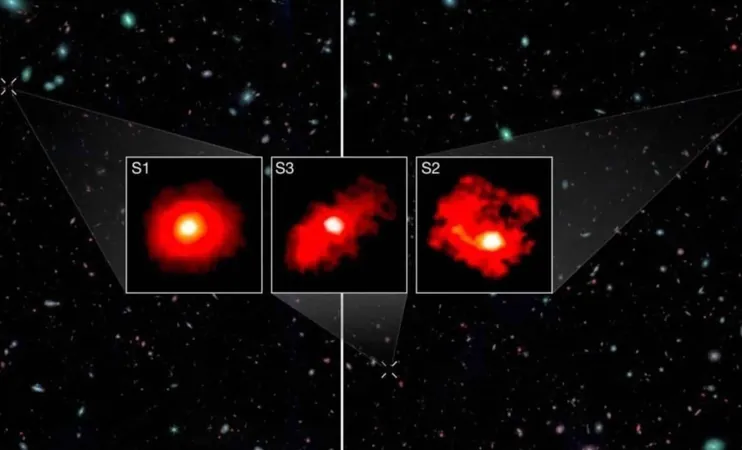
Unveiling Cosmic Giants: NASA's James Webb Telescope Discovers 'Red Monsters' in the Early Universe
2025-04-28
Author: Ming
NASA's Game-Changer: The James Webb Space Telescope
The James Webb Space Telescope (JWST) is rewriting our cosmic history! A groundbreaking discovery has unveiled enormous galaxies, affectionately dubbed 'red monsters,' which formed at a pace no one anticipated in the infancy of the universe.
Shattering Our Understanding of Cosmic Growth
Since becoming operational, JWST has unveiled a universe teeming with activity—far richer than the previous models predicted. Studies suggest that the early cosmos housed 10 to 100 times more galaxies than scientists ever believed possible.
Some of these ancient galaxies appear larger and more organized than could have been thought feasible for their time, prompting intrigue about 'impossible' galaxies that seemed to defy the known laws of physics.
Introducing the 'Red Monsters'
In a significant survey known as FRESCO, astronomers utilized JWST to explore 36 massive galaxies, identifying three standout 'red monsters.' These celestial giants managed to convert nearly half of their available matter into new stars, with a staggering star-formation rate that is an astonishing 500 times faster than what we observe in our own Milky Way today.
Mengyuan Xiao, a postdoctoral researcher from the University of Geneva and lead author of the study, heralded these galaxies as 'the beginning of a new era' for our exploration of the universe, hinting at an astonishingly efficient star-forming capability.
The Mystery Behind Their Rapid Growth
But how did these 'red monsters' achieve such rapid growth? One hypothesis suggests they emerged from densely packed regions, facilitating an easier influx of gas to fuel star formation, akin to ancient versions of modern galaxy clusters.
Another explanation points to supermassive black holes that were already active in those early days. These colossal black holes might have played a role in compressing the surrounding gas, accelerating stellar creation. However, as David Elbaz, an astrophysicist and co-author of the study, noted, there is still much to unravel about how a universe could be so structured so soon.
Digging Deeper into Cosmic Origins
Further findings from the FRESCO survey reveal that galaxy formation rates during the epochs between redshifts 5 and 9 were two to three times higher than those of the most efficient galaxies discovered in later stages.
These 'red monsters' belong to a unique group of dust-rich, star-forming galaxies that are often hidden from optical view, detectable mainly through advanced imaging and spectral analyses provided by JWST’s NIRCam instrument.
By collaboratively analyzing their structural and star-formation characteristics, researchers discovered that these galaxies are massive systems genuinely focused on star creation, rather than being dominated by active galactic nuclei.
A Brand New Perspective on Cosmic Evolution
The extraordinary early growth of these galaxies emphasizes how quickly cosmic structures formed, defying previously held expectations and reshaping our comprehension of the universe’s evolution. More data and refined simulations are essential to achieve a clearer picture of the processes at play during this remarkable cosmic chapter.




 Brasil (PT)
Brasil (PT)
 Canada (EN)
Canada (EN)
 Chile (ES)
Chile (ES)
 Česko (CS)
Česko (CS)
 대한민국 (KO)
대한민국 (KO)
 España (ES)
España (ES)
 France (FR)
France (FR)
 Hong Kong (EN)
Hong Kong (EN)
 Italia (IT)
Italia (IT)
 日本 (JA)
日本 (JA)
 Magyarország (HU)
Magyarország (HU)
 Norge (NO)
Norge (NO)
 Polska (PL)
Polska (PL)
 Schweiz (DE)
Schweiz (DE)
 Singapore (EN)
Singapore (EN)
 Sverige (SV)
Sverige (SV)
 Suomi (FI)
Suomi (FI)
 Türkiye (TR)
Türkiye (TR)
 الإمارات العربية المتحدة (AR)
الإمارات العربية المتحدة (AR)